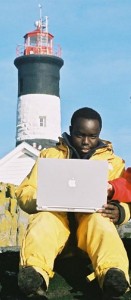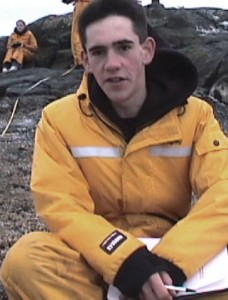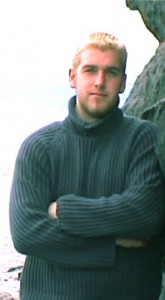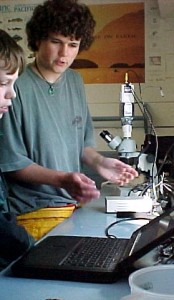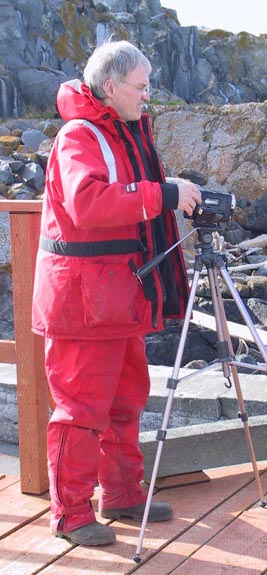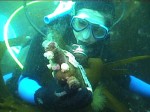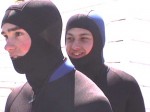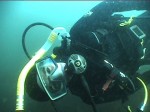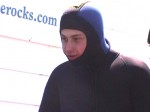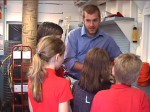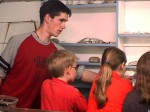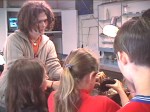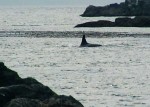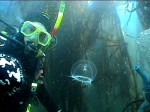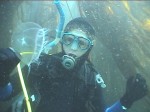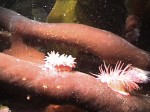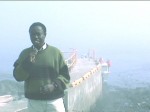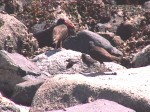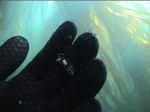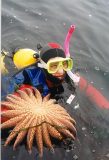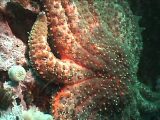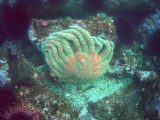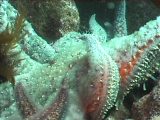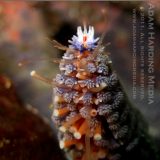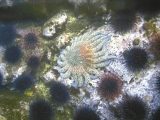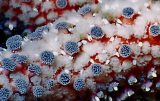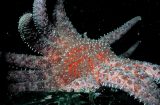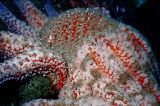Pam and Jason from Archipelago Marine do their underwater survey of the location of the Piling Drilling for the Current Energy Project. They monitor area at ~18 meters depth. October 26, 2005Frequent visits from sealions frequently distract Juan Carlos as he takes the video.
Category Archives: Diving Videos
Blue water Diving — Pearson College Divers
Henry Steinberg, Julia Clarke and Laura Verhegge do their first tether dive with Chris off the shores of Race Rocks in Race Passage. The apparatus for the dive was constructed by Henry Steinberg, a Pearson College diver, as part of a project in his PADI Divemasters course. This type of diving is useful for research purposes when one wants to sample jellyfish, salps or other macro-planktonic life forms which may otherwise be damaged if collected in a towed plankton net. It is also necessary as a safety measure for drift diving when the bottom is beyond safety limits, and there are currents involved such as here in the Strait of Juan de Fuca.
Installation of Succession plates for the Tidal Energy project
This video shows the installation process for the tidal energy generator research project. This was carried out by Chris Blondeau and the Pearson College Divers in order to determine which surfaces discouraged growth in the waters at Race Rocks. As a result, Titanium was used in the construction of some parts of the generator as it was one of the metals most resistant to fouling.
Deploy and Retrieve ADCP Instrument 2005
In order to predict the best location for the installation of the tidal power generator, an ADCP ( Acoustic Doppler Current Profiler) supplied by ASL Environmental Sciences was deployed. This instrument will collect current regime information for a period of one month. Rita Santos did the video and Angie Karlsen helped Chris Blondeau lift and position the concrete weights used to secure the device on the sea floor..
First Nations Divers at Race Rocks
November 2, 2003 : We hosted a group of divers from the Nass River area on a dive at Race Rocks. Accompanying the Divers were Matt Hill and his wife Joanne. Matt who comes from Dolphin Island near Prince Rupert, provided some interesting information about the interactions of the people of his nation with marine resources.
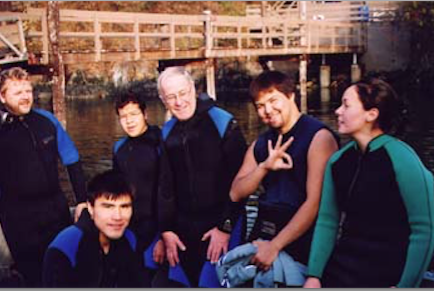
Webcasting Crew at Race Rocks for the Johan Ashvud RR’02 Project
MEET THE CREW:
| — |
“We had a great time webcasting live from Race Rocks on Camera 4 during the first two weeks of June for the Johan Ashuvud Race Rocks02 Project”
Three current first year students from Pearson College and Ryan Murphy, who graduated last year stayed at the Marine Science Centre. Ryan is returning to Race Rocks this month to do research for Mt.Allison Univ. on the macroalgal community.
See one video on Pterygophora which was one part of his project here: They conducted daily live and prerecorded webcasts with Garry Fletcher from the intertidal and from underwater using camera 4.
For one of the webcasts we were joined by Sean LeRoy, Graduate Researcher, Georgia Basin Futures Project Sustainable Development Research Institute, University of British Columbia and Dr.James Tansey also of UBC. They came to participate in the webcast with Garry and Ryan on Marine Protected Areas in new Zealand and Canada with Tim Langlois, Leigh Marine Laboratory University of Auckland, and Anne Saloman, University of Washington, Zoology Department.
On three days we hosted small groups of students from local elementary schools who served as proxies in webcasts done for their classmates.
Support for the Race Rocks 02 Project came from the Johan Ashuvud Race Rocks Memorial Fund
Below are some of the Videos produced by the crew during the week.
 |
 |
 |
| Ben’s movie put together during the week. | June 2002 field trip: for a live webcast with the crew, of the grade six students from West-Mont school . | One morning we found the body of an octopus washed up in the intertidal zone. An impromptu dissection led to this video. |
- Ryan with a bottle on one of his many dives studying macroalgae that week.
- Joe and Jedrzej prepare for a dive .
- Joe just doing his thing??
- Jedrzej
- Ben discusses the black Oystercatcher food web with the Grade six students of West-Mont School
- Joe and the students from West-Mont School
- Ryan demonstrates the escape response of the abalone.
- We did three live webcasts with visiting school groups ( see video above)
- One of our Orca visitors that week filmed by Ben.
- Joe contemplating a medusa.
- In this clip from a video taken by Jedrzej, Ryan also encounters the medusa.
- Michael Kiprop announcing the morning webcast live on camera 4.
- The 4 Black oystercatcher families which have successfully hatched, can be seen frequently feeding with their chicks in the low intertidal zone.
- We finally found out this creature was..Euphysa It was filmed by Jedrzej as it drifted with the plankton.
Pycnopodia helianthoides: Sunflower star–The Race Rocks taxonomy
- Loreen Pindera displays the oral side of the pycnopodia to shore-bound visitors.
- The dorsal side , with grey tufts where the gills are loated. White pincers on the dorsal side are the pedicellaria
- Photos by Pearson College Divers.
- The tube feet of the Pycnopodia
- Adam Harding took this picture of the red eye spot at the end of a tentacle.
- forcep-like structures used to defend the surface. A good habitat image of bith Pycnopodia and the giant red urchin.
- Close up of pedicellaria, tiny forcep-like structures used to defend the surface.
- Pycnopodia : These three last photos are derived from photos by Dr.A.Svoboda
- Dorsal surface showing gills
Pycnopodia tend to be found thriving in regions rich in seaweed, in low intertidal zones on rocky shores. They have an arm radius that ranges from forty to sixty-five centimeters. Small juveniles have five arms but develop twenty four by the time they are adults. Pycnopodia have an aboral surface and are usually pink, purple or brown in color. Occasionally they will be red or yellow in color. They also have the ability to regenerate lost arms. Pycnopodia are the largest, heaviest and most active of the Pacific coast sea stars. Pycnopodia feed on Stronglyocentrotus purpuratus (the purple sea urchin), bivalves, polychaetes, chitons, snails, hermit crabs, crabs, sea cucumber, and Leptasterias sea stars . The Pycnopodia utilize over fifteen thousand sucker feet when capturing prey. Their prey is swallowed whole and digested internally, and they have the ability to partially evert their stomach. Antagonistic, combative behavior has been observed when two Pycnopodia encounter one another. The key predator of the Pycnopodia is the King Crab. A fourfold increase in speed has been noted when the Pycnopodia is in contact with a predator. If the Pycnopodia does not escape, the predator will latch on to one of its many arms and begin to feed.
The sea star Pycnopodia helianthoides is one of the largest invertebrate predators at Race Rocks. In this close up view, on the dorsal side, the pinkish tufts contain the pedicellariae (small pincers) and the dermal branchiae (for gas exchange) On the ventral view, the central mouth is surrounded by many tube feet.
In October, 2001, federal Fisheries Minister Herb Dahliwal and the Provincial Environment Minister Joan Sawiki visited Race Rocks to officially proclaim the opening of the Race Rocks MPA. In this video, Ryan Murphy shows the ministers a Pycnopodia.
Domain Eukarya
Kingdom Animalia
Phylum Echinodermata
Class Asteroidea
Order Forcipulatida
Family Asteriidae
Genus Pycnopodia
Species helianthoides
common nameSunflower Star
References cited:
Marine Invertebrates of the Pacific Northwest, Eugene N Kozloff, 1996, University of Washington Press
Intertidal Invertebrates of California, Robert H Morris Donald P Abbot and Eugene C Haderlie, 1980, Stanford University Press
Pacific Seashores- A Guide to Intertidal Ecology, Thomas Carefoot, 1977, J.J. Douglas Ltd
| Other Members of the Phylum Echinodermata at Race Rocks |
and Image File |
 The Race Rocks taxonomy is a collaborative venture originally started with the Biology and Environmental Systems students of Lester Pearson College UWC. It now also has contributions added by Faculty, Staff, Volunteers and Observers on the remote control webcams. The Race Rocks taxonomy is a collaborative venture originally started with the Biology and Environmental Systems students of Lester Pearson College UWC. It now also has contributions added by Faculty, Staff, Volunteers and Observers on the remote control webcams.
December 2001- Hannah McKinnnon (PC) |
Webcast to Conference in New York from underwater Race Rocks
During a presentation to the ETC conference at the United Nations School in New York in the spring of 2001, we tried out the underwater audio link from DIVELINK . An audio signal is relayed by SONAR for Ryan to a receiver near the docks. This receiver was connected to the audio input on the G3 laptop computer and to the shore tender as well. Both voices could be carried by the Sorenson Broadcaster first by wireless AirPort and then onto the internet. In this way we were able to communicate from underwater in the Pacific Ocean live by internet to the Altlantic coast. In this video, Ryan Murphy, a student at Pearson College, operates the device and the camera was operated by Jean-Olivier Dalphond, also a student at the college.
Fouling or Succession
Already by March, the growth of algae on the environmental sensors and the aluminum bar has been prolific. Regular dives have to be made to keep the sensors free of algae. The predominant Genus here is Laminaria.
Installation of Sensor Bar underwater at Race Rocks
In this video, the diving students of Lester Pearson College brave several cold hours in the water to bolt down the 5 meter aluminum sensor bar in 8 meters of water off the docks at Race Rocks. Faculty members Garry Fletcher and Chris Blondeau join them to help install the first three sensors.
The orange rope previously installed in the 3 inch conduit is attached to the top end of the sensor cables. These cables are pulled through the buried conduit from the installation location in the ocean, up to the top of the docks where they connect with the instrumentation to allow the data eventually to be made available on-line. The sensors are brought down by a diver and fitted to the bar as the cable gets pulled through. Next the crew straps the sensors and their electrical terminal boxes to the bar. The hydrophone points upwards, the other two sensors, for chlorophyll and turbidity point down. A special thanks is due to our video expert Jean-Olivier Dalphond for enduring almost three hours in the 8 degree Celsius water to video the process.

